| 高性能锂离子电池负极材料瓜状介孔Fe3O4/氮掺杂碳的制备及性能研究 |
2. 齐鲁工业大学(山东省科学院) 新材料研究所,济南 250014
2. Advanced Materials Institute, Qilu University of Technology(Shandong Academy of Sciences), Jinan 250014, China
锂离子电池作为新一代绿色高能可充电电池, 以其能量密度高、使用寿命长、安全性好、开路电压高、质量轻、体积小、无记忆效应等优点而广泛应用于各类便携式电子设备中, 并得到众多研究者的青睐[1-3]。然而因碳负极材料的储锂能力较低(理论容量372 mAh·g-1), 不能满足大型电子设备的需求[4-5], 从而抑制了锂离子电池的发展。所以目前锂离子电池的研究集中于发现或制造储锂性能更优越的负极材料。
研究发现Fe3O4具有很高的理论比容量(928 mAh·g-1, 相当于石墨理论比容量的2.5倍), 而且成本较低, 对环境友好, 进而引起广泛关注[6-8]。但同时也发现在充放电过程中Fe3O4的体积会发生较大变化, 而导致电极内部结构遭到破坏, 容量衰减严重。解决这一问题常用的策略是在Fe3O4颗粒表面包覆碳材料[9-11]。碳包覆不仅能够提高复合物的导电性, 而且能够阻止颗粒间相互聚集和微结构破坏。介孔微纳米结构既有利于电解液的渗透、锂离子的快速迁移, 而且能够保证电极材料具有较高的能量密度[12-14]。所以研制具有介孔微纳米结构的碳包覆Fe3O4复合材料已经成为目前的研究热点。
本文通过简单的低温水热反应法制备出了一种具有新型瓜状介孔Fe3O4/氮掺杂碳复合物, 并以此作为锂离子电池负极的活性材料组装了锂离子电池, 展现出了较高的倍率性能和优异的循环稳定性能, 可为锂离子电池的进一步研究和开发提供参考。
1 实验 1.1 材料制备瓜状介孔Fe2O3微晶的制备:将30 mL 5.4 M的NaOH溶液加入到75 ℃加热的30 mL 3 M的FeCl3·6H2O溶液中, 磁力搅拌10 min。将混合溶液倒入100 mL带盖玻璃瓶中, 盖紧盖子后放入鼓风干燥箱中, 在100 ℃下反应4天。反应完成后, 抽滤, 用水和无水乙醇洗涤多次, 放入干燥箱中(80 ℃)干燥6 h。
瓜状介孔Fe3O4/N-C复合物的制备:将160 mg Fe2O3和80 mg多巴胺溶于100 mL 10 mM的三羟甲基氨基甲烷缓冲液(pH=8.5)中, 磁力搅拌12 h。反应结束后, 抽滤, 用水和无水乙醇洗涤多次, 放入干燥箱中(80 ℃)干燥6 h。得到的样品放入石英管中, 在高温(600 ℃)和氮气气氛下煅烧2 h。
1.2 锂离子电池组装将制备的活性物质瓜状介孔Fe3O4/N-C复合物样品、Super P(导电剂)、聚偏氟乙烯(PVDF)按照质量比70:20:10混合, 加入一定量N-甲基吡咯烷酮(NMP), 调成浆状。使用涂膜仪将浆料均匀平铺于铜箔上, 于80 ℃真空干燥箱中干燥12 h, 切片。使用金属锂片为对电极和参比电极, Celgard聚丙烯多孔膜为隔膜, 1 M LiPF6(溶解于体积比为1:1:1的EC/DMC/DEC混合溶液中)为电解液, 在充满氮气(纯度为99.999%)的手套箱中组装成CR2032型纽扣电池。
1.3 分析测试仪器产物的物相由日本岛津XRD-6100型X射线粉末衍射仪(XRD)检测, 使用Cu靶线源(CuKα, λ=1.541 8 nm)测定。场发射扫描电子显微镜(SEM)图片通过场发射扫描显微镜(蔡司G500)获得。透射电子显微镜(TEM)图片及高分辨透射电镜(HRTEM)图片通过透射电子显微镜(日本JEOL公司, TF20, Jeol 2100F)获得。热重(TG)分析由瑞士梅特勒公司TGA-1热重分析仪测试。多站可扩展比表面积(BET)及孔径分析仪(康塔Autosorb-iQ-MP)测试比表面积和孔径分布。元素分析由X射线光电子能谱(XPS, Thermo ESCALAB 250XI)测试。电池组装完毕后, 室温下在LAND CT 2001电池测试系统(武汉蓝电电子有限责任公司)完成测试, 测试电压范围为0.01~3.0 V。使用PARSTAT 2263电化学工作站(美国普林斯顿)测试电池的循环伏安曲线。
2 实验结果与讨论从XRD谱图(图 1a)可以看出:前驱体为纯六方相赤铁矿α-Fe2O3相, 所有衍射峰能够与标准衍射卡片(JCPDF No.72-0469)很好地对应。N2等温吸脱附曲线(图 1b)存在着明显的滞后环, 为典型的介孔特征[15], 比表面积为51.05 m2/g。孔径分布图(图 1c)表明样品平均孔径约为4 nm。
 |
| 图 1 前驱体Fe2O3的XRD谱图(a)、N2等温吸脱附曲线(b)和孔径分布图(c) |
图 2为前驱体Fe2O3的扫描电镜图(a、b)和透射电镜图(c、d)。从中可以看出:样品为甜瓜状微粒, 长400~800 nm, 宽约200 nm。微粒表面比较粗糙, 而且存在着很多孔隙。Fe2O3微粒是由许多细小纳米颗粒组成的。
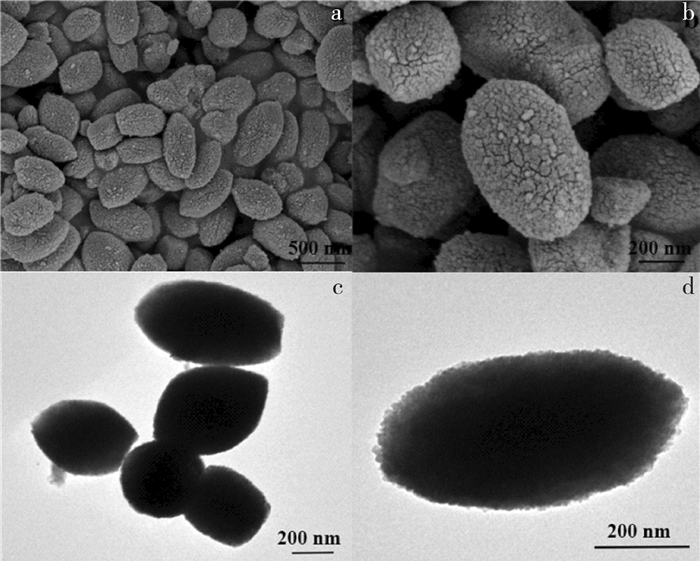 |
| 图 2 前驱体Fe2O3的扫描电镜图(a、b)和透射电镜图(c、d) |
从图 3a中可以看出, 经过多巴胺聚合后Fe2O3微粒表面变得光滑平整, 说明颗粒表面均匀包覆了一层聚多巴胺。图 3b表明聚多巴胺层厚约30 nm。
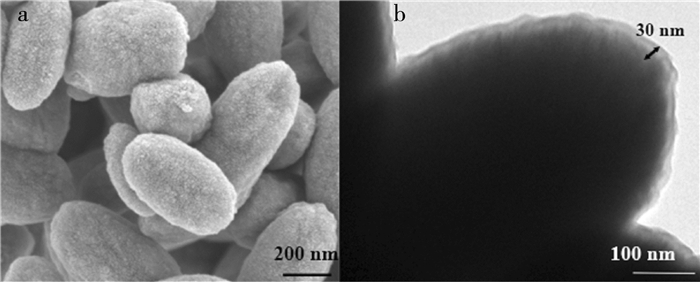 |
| 图 3 Fe2O3@聚多巴胺的扫描电镜图(a)和透射电镜图(b) |
Fe2O3@聚多巴胺煅烧后, XRD谱图(图 4a)表明样品为纯立方相磁铁矿Fe3O4相, 所有衍射峰位置与标准衍射卡片(JCPDF No.88-0315)相一致。热重分析曲线(图 4b)表明样品中碳含量约为8.1%。N2等温吸脱附曲线(图 4c)存在明显的滞后环, 证明有气孔存在, 比表面积为29.848 m2/g。孔径分布图(图 4d)显示孔径主要分布在20 nm以下, 表明该复合物为典型的介孔材料。
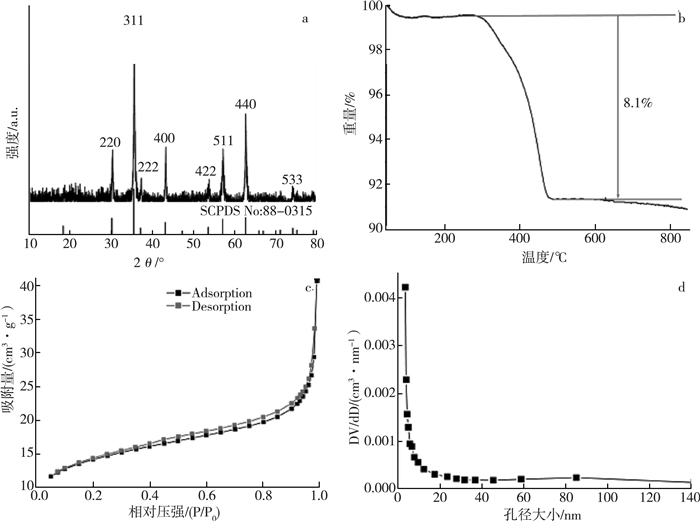 |
| 图 4 Fe3O4/N-C复合物的XRD谱图(a)、TG曲线(b)、N2等温吸脱附曲线(c)和孔径分布图(d) |
扫描电镜谱图(图 5a)和透射电镜谱图(图 5b、c)表明Fe3O4/N-C样品内部出现明显的孔隙, 表面碳化后形成10~15 nm厚的碳层。高分辨率透射电镜谱图(图 5d)揭示晶格间距为0.25 nm, 对应Fe3O4(311)晶面间距。
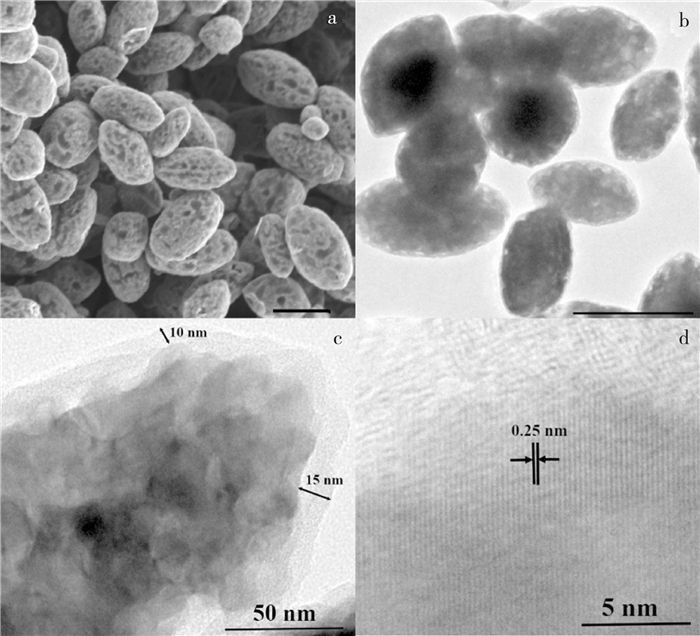 |
| 图 5 Fe3O4/N-C复合物的SEM谱图(a)、TEM谱图(b、c)和HRTEM谱图(d) |
XPS谱图(图 6a)表明样品中存在着C、N、O、Fe元素。N1s谱图(图 6b)显示电子结合能位于398 eV和400 eV, 分别对应于C-N和C=N, 表明样品中存在N的多重化学态, 氮掺入到碳材料之中[16-17]。Fe2p谱图(图 6c)中电子结合能位于711 eV和724 eV, 分别对应于Fe3O4的Fe 2p3/2和Fe 2p1/2。711 eV电子结合能证明样品中存在Fe3+(电子结合能位于710.4 eV)和Fe2+(电子结合能位于715 eV)[18]。
 |
| 图 6 Fe3O4/N-C复合物的XPS谱图(a)、N1s谱图(b)和Fe2p谱图(c) |
CV曲线(图 7a)表明, 在0.9/1.8 V处存在氧化还原峰, 对应于Fe3O4电极的嵌锂/脱锂过程。图 7b为0.5 A·g-1电流密度下第1~3次充放电曲线, 从图中可以看出放电平台约为0.9 V。倍率性能图(图 7c)表明, 在0.5、1、2、5、10 A·g-1电流密度下放电比容量分别为910、777、606、385、200 mAh·g-1。接着在0.5 A·g-1电流密度下放电容量能重新恢复到880 mAh·g-1, 表明电极具有很好的可逆性。图 7d为在2 A·g-1电流密度下的循环曲线。经过1 500次循环充放, 放电容量几乎没有衰减, 库伦效率接近100%。这主要得益于介孔结构和氮掺杂碳的双重作用。介孔结构提供了较大的活性物质与电解液接触面积, 提高了锂离子扩散能力。而且介孔结构能够提供空间, 缓解Fe3O4充放电过程的体积变化对电极材料的破坏作用。氮掺杂碳提高了Fe3O4/N-C复合物的电子导电能力, 有利于电子快速转移, 从而提高了倍率性能。
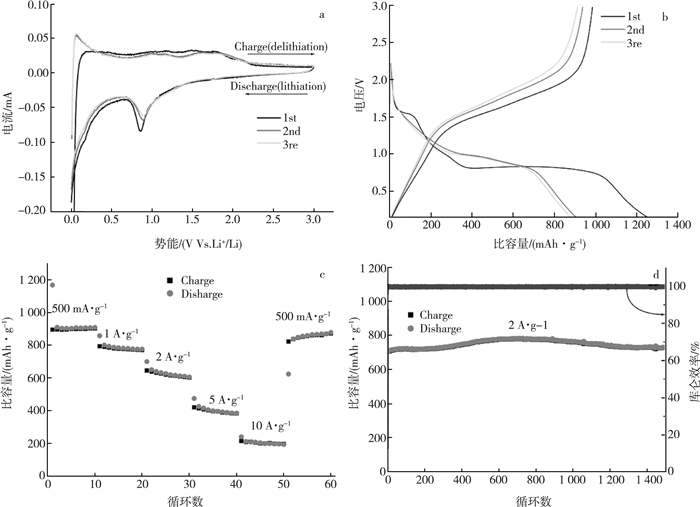 |
| 图 7 Fe3O4/N-C复合物的CV曲线(a)、充放电曲线(b)、倍率性能图(c)和循环稳定性能图(d) |
3 结论
采用简单的低温水热和聚多巴胺包覆热处理的方法成功制备了具有瓜状介孔Fe3O4/N-C复合物。作为锂离子电池负极材料, 展示出了超高的倍率性能, 在0.5、1、2、5、10 A·g-1电流密度下放电比容量分别为910、777、606、385、200 mAh·g-1。同时也具有优异的循环稳定性能, 在2 A·g-1电流密度下循环1 500次放电容量几乎没有衰减, 库伦效率接近100%。该复合物有望成为一种新型锂离子电池负极材料。
| [1] |
ZHANG C, JIN C Z, TENG G X, et al. Controllable synthesis of hollow MnFe2O4by self-etching and its application in high-performance anode for lithium-ion batteries[J]. Chemical Engineering Journal, 2019, 365: 121-131. DOI:10.1016/j.cej.2019.02.004 |
| [2] |
YANG Z T, LIU X J, FENG X L, et al. Hydrothermal synthesized micro/nano-sized pyrite used as cathode material to improve the electrochemical performance of thermal battery[J]. Journal of Applied Electrochemistry, 2014, 44(10): 1075-1080. DOI:10.1007/s10800-014-0724-9 |
| [3] |
OH J, LEE J, JEON Y, et al. Mela mine foam-derived N-doped carbon framework and graphene-supported LiFePO4 composite for high performance lithium-ion battery cathode material[J]. ACS Sustain.Chem.Eng., 2019, 7(1): 306-314. DOI:10.1021/acssuschemeng.8b03390 |
| [4] |
LIS M, CHUDZIK K, BAKIERSKA M, et al. Aqueous binder for nanostructured carbon anode materials for Li-ion batteries[J]. Journal of the Electrochemical Society, 2019, 166(3): A5354-5361. DOI:10.1149/2.0591903jes |
| [5] |
LIU Y Z, YANG C H, PAN Q C, et al. Nitrogen-doped bamboo-like carbon nanotubes as anode material for high performance potassium ion batteries[J]. Journal of Materials Chemistry A, 2018, 6(31): 15162-15169. DOI:10.1039/C8TA04694H |
| [6] |
DUAN Y J, ZHAO D L, LIU X H, et al. Novel design of Fe3O4/hollow graphene spheres composite for high performance lithium-ion battery anodes[J]. Journal of Alloys and Compounds, 2019, 779: 466-473. DOI:10.1016/j.jallcom.2018.11.304 |
| [7] |
CHEN Q W, ZHONG W, ZHANG J N, et al. Fe3O4 nanorods in N-doped carbon matrix with pseudo-capacitive behaviors as an excellent anode for subzero lithium-ion batteries[J]. Journal of Alloys and Compounds, 2019, 772: 557-564. DOI:10.1016/j.jallcom.2018.09.157 |
| [8] |
CHEN S P, WU Q N, WEN M, et al. Sea-sponge-like structure of nano-Fe3O4 on skeleton-C with long cycle life under high rate for Li-ion batteries[J]. ACS Appl.Mater.Inter., 2018, 10(23): 19656-19663. DOI:10.1021/acsami.8b02839 |
| [9] |
CHEN Y Q, ZHENG L, FU Y Y, et al. MOF-derived Fe3O4/carbon octahedral nanostructures with enhanced performance as anode materials for lithium-ion batteries[J]. Rsc.Adv., 2016, 6(89): 85917-85923. DOI:10.1039/C6RA19041C |
| [10] |
CHAI X H, SHI C S, LIU E Z, et al. Carbon-coated Fe2O3 nanocrystals with enhanced lithium storage capability[J]. Appl.Surf.Sci., 2015, 3447: 178-185. |
| [11] |
CHEN S H, ZHOU R H, CHEN Y Q, et al. Carbon-covered Fe3O4 hollow cubic hierarchical porous composite as the anode material for lithium-ion batteries[J]. Journal of Nanoparticle Research, 2017, 19: 127. DOI:10.1007/s11051-017-3794-x |
| [12] |
XIAO Z, XIA Y, REN Z H, et al. Facile synthesis of single-crystalline mesoporous alpha-Fe2O3 and Fe3O4 nanorods as anode materials for lithium-ion batteries[J]. Journal of Materials Chemistry, 2012, 22(38): 20566-20573. DOI:10.1039/c2jm34083f |
| [13] |
YU Y, DHANABALAN A, GU L, et al. Hierarchically macroporous and mesoporous sponge-like Fe3O4 thin film electrodes for application in Li-ion batteries[J]. Nanosci.Nanotech.Let., 2012, 4(10): 983-988. DOI:10.1166/nnl.2012.1441 |
| [14] |
ZHANG Q T, YAN C, MENG Y, et al. Hierarchical mesoporous Li2FeSiO4/C sheaf-rods as a high-performance lithium-ion battery cathode[J]. Journal of Alloys and Compounds, 2018, 767: 195-203. DOI:10.1016/j.jallcom.2018.07.105 |
| [15] |
YUAN S M, ZHOU Z, LI G. Structural evolution from mesoporous alpha-Fe2O3 to Fe3O4@C and gamma-Fe2O3 nanospheres and their lithium storage performances[J]. Cryst.Eng.Comm., 2011, 13(14): 4709-4713. DOI:10.1039/c0ce00902d |
| [16] |
ZHU B X, GUO G N, WU G H, et al. Preparation of dual layers N-doped carbon@mesoporous carbon@Fe3O4 nanoparticle superlattice and its application in lithium-ion battery[J]. Journal of Alloys and Compounds, 2019, 775: 776-783. DOI:10.1016/j.jallcom.2018.10.224 |
| [17] |
NGUYEN T A, LEE S W. Green synthesis of N-doped carbon modified iron oxides(N-Fe2O3@Carbon) using sustainable gelatin cross-linker for high performance Li-ion batteries[J]. Electrochim.Acta., 2017, 248: 37-45. DOI:10.1016/j.electacta.2017.07.114 |
| [18] |
SHEN L S, SONG H W, CUI H, et al. Fe3O4-carbon nanocomposites via a simple synthesis as anode materials for rechargeable lithium ion batteries[J]. Cryst.Eng.Comm., 2013, 15(46): 9849-9854. DOI:10.1039/c3ce41486h |
 2019, Vol. 33
2019, Vol. 33


